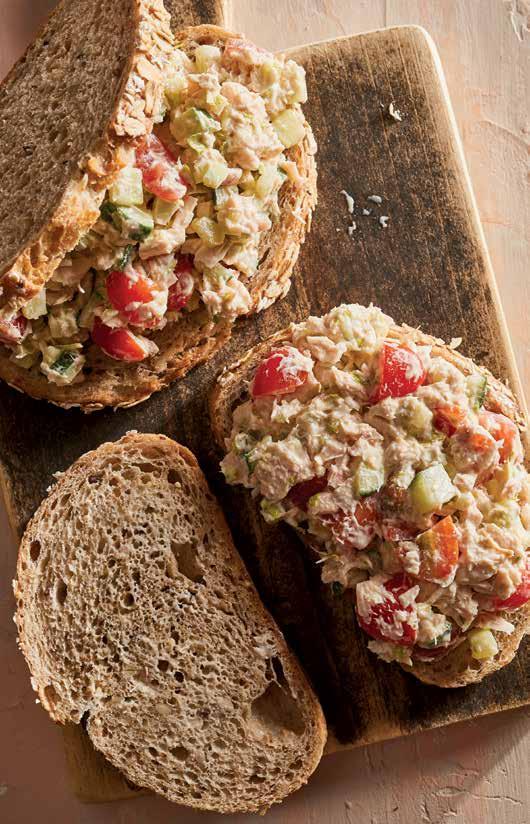
3 minute read
No-Cook Lunch Tuna Salad with Tomatoes
For this quick lunch idea, we drain the tuna well, which results in a salad that doesn’t sog up the bread. Serve on top of greens or as a sandwich between slices of whole-grain bread or tucked into a whole-grain pita.
HANDS-ON TIME: 20 MINUTES TOTAL TIME: 20 MINUTES MAKES: 2 SERVINGS
Advertisement
INGREDIENTS 1 (5-ounce) can tuna (any kind) 6 cherry or grape tomatoes, cut into quarters ½ small cucumber, peeled or scrubbed and diced 2 tablespoons chopped celery leaves, fresh dill, or fresh parsley 2 tablespoons plain Greek or regular yogurt 1 tablespoon olive or vegetable oil 1 teaspoon Dijon mustard ½ teaspoon kosher salt INSTRUCTIONS 1. Set a colander in the sink, then empty the tuna into it. Using a fork, press down on the tuna to squeeze out the liquid. 2. Transfer the drained tuna to a large bowl and add all the remaining ingredients. Stir gently; you want to combine the ingredients well but avoid breaking up the tuna too much. 3. Serve right away, or cover and refrigerate at least 1 hour and up to 24 hours.
Or You Could Add additional flavor with ½ teaspoon dried herbs, such as thyme or oregano. Another great option is herbes de Provence, which is a combination of dried herbs from the Provence region of France, usually including thyme, oregano, savory, marjoram, and rosemary, as well as lavender leaves. So even ½ teaspoon packs a lot of flavor.
WHEN TO WASH IT Moisture can promote the growth of mold and bacteria, so it’s important to wash produce right before you use it rather than before storing it. It’s a waste of money and shopping time, not to mention just a plain waste of food, when produce goes bad. To minimize all those types of loss, it helps to know where and how each type of produce should be stored. Here are some tips.

HOW TO PACKAGE IT To prevent moisture loss, it’s usually best to store produce in the packaging in which it was sold. Very often these bags or other containers are designed to let ethylene gas (which promotes ripening) escape while keeping most moisture in. Another option is to store your produce in partially open plastic produce bags. An exception: Whole cucumbers, zucchini, and summer squash should be tightly wrapped in plastic wrap for storage.

WHERE TO STORE IT
At Room Temperature On the kitchen counter but not in direct sunlight: • Tomatoes, lemons, limes, oranges, and grapefruit • Fruits that continue to ripen after being picked (called “climacteric” fruits): bananas, mangoes, peaches, nectarines, plums, and papayas
In the pantry or a drawer at cool room temperature and away from light: • Garlic, onions, shallots, potatoes, sweet potatoes, and winter squashes


In the Refrigerator Not all parts of your refrigerator are the same. The coolest area is the back of the fridge on the top and middle shelves, while the warmest is the front on the middle and bottom shelves—the temperature difference can be as much as 10 degrees. The most humid part of the fridge is the crisper drawer. Different types of produce do best in different areas. In the back, where the temperature is lowest: • Fruits not sensitive to chill-injury: apples, grapes, and cherries At the front, where the temperature is highest: • Fruits sensitive to chill-injury: melons, pears, avocados, and all types of berries
In the Crisper Almost all vegetables do best in the humid environment of the crisper, including beets, broccoli, cabbage, carrots, cauliflower, celery, corn, cucumbers, eggplants, green beans, herbs, kale and other leafy greens, lettuces, mushrooms, peppers, radishes, rhubarb, summer squash, and zucchini









